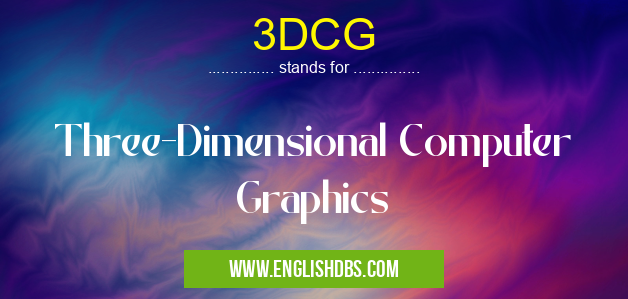What does 3DCG mean in COMPUTING
3DCG stands for Three-Dimensional Computer Graphics. It is a technology used to create digital representations of three-dimensional objects, environments, and worlds. 3DCG is widely used in various industries, including entertainment, engineering, architecture, and scientific visualization.

3DCG meaning in Computing in Computing
3DCG mostly used in an acronym Computing in Category Computing that means Three-Dimensional Computer Graphics
Shorthand: 3DCG,
Full Form: Three-Dimensional Computer Graphics
For more information of "Three-Dimensional Computer Graphics", see the section below.
Subheadings
What is 3DCG?
3DCG is the process of creating virtual three-dimensional objects using computer software. These objects can range from simple shapes to complex models with intricate details and textures. 3DCG artists utilize specialized software to manipulate vertices, edges, and faces to construct 3D models.
Techniques in 3DCG
Various techniques are employed in 3DCG, including:
Modeling: Creating the basic shape and structure of 3D objects.
Texturing: Applying colors, patterns, and textures to the surfaces of 3D models.
Animation: Giving movement and life to 3D objects through keyframing and rigging.
Lighting: Enhancing the realism and depth of 3D scenes by simulating the effects of light and shadow.
Applications of 3DCG
3DCG has numerous applications in various fields:
Entertainment: Creating stunning visuals for movies, video games, and animations.
Engineering: Designing and simulating complex products, machinery, and structures.
Architecture: Visualizing building plans, interiors, and landscapes with realistic detail.
Scientific Visualization: Representing complex data and scientific concepts in an interactive and engaging way.
Essential Questions and Answers on Three-Dimensional Computer Graphics in "COMPUTING»COMPUTING"
What is 3DCG?
3DCG (Three-Dimensional Computer Graphics) refers to the creation and manipulation of digital representations of three-dimensional objects or scenes using computer software. It is used in various fields such as animation, gaming, architecture, and engineering.
How is 3DCG different from traditional 2D animation?
Traditional 2D animation involves creating images frame by frame, while 3DCG uses computer-generated models that can be manipulated, rotated, and scaled to create moving images. This allows for greater flexibility and realism in creating 3D environments and characters.
What are the key components of 3DCG?
The main components of 3DCG include:
- Modeling: Creating the 3D models that represent objects or characters.
- Animation: Bringing these models to life by moving and manipulating them over time.
- Texturing: Applying surface textures to the models to make them appear more realistic.
- Lighting: Setting up virtual lights to illuminate the 3D scene and create shadows.
- Rendering: Generating the final images or animations from the 3D models.
What are the advantages of using 3DCG?
3DCG offers several advantages over traditional animation, including:
- Realism: 3DCG can create highly realistic images and animations that mimic real-world objects and environments.
- Flexibility: 3D models can be easily modified and reused in different scenes, reducing production time.
- Immersion: 3DCG can create immersive experiences that engage viewers and make them feel part of the scene.
What are the challenges of 3DCG?
While 3DCG offers many benefits, it also presents some challenges:
- Technical Complexity: 3DCG software and techniques can be complex and require specialized knowledge.
- Computational Intensity: Rendering 3D scenes can be computationally expensive, especially for complex models and animations.
- Storage Space: 3D models and animations can take up significant storage space due to their large file sizes.
What are the career opportunities in 3DCG?
3DCG skills are in high demand in industries such as:
- Animation: Creating 3D models, animations, and visual effects for films, TV shows, and video games.
- Game Development: Developing 3D environments, characters, and gameplay for video games.
- Architecture and Engineering: Using 3DCG for architectural visualization, engineering simulations, and product design.
Final Words: 3DCG has revolutionized the way we interact with digital content. It enables the creation of immersive and realistic three-dimensional experiences that enhance entertainment, aid in design and planning, and contribute to scientific understanding. As technology continues to advance, 3DCG will continue to play a vital role in shaping the future of digital media and innovation.
